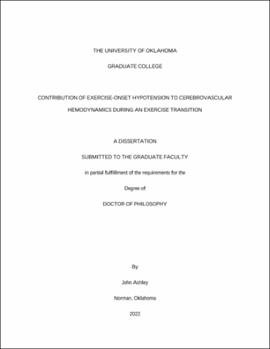| dc.description.abstract | Recent evidence suggests cerebral blood flow (CBF) responds to moderate intensity exercise after ~ 40s when using a monoexponential model to characterize CBF kinetics. Considering the brain’s reliance on blood flow for O2 and substrate delivery during increased metabolic demands, this delay is concerning. Especially when other physiological systems that are less dependent on blood flow for immediate energy needs respond to exercise within 10s (e.g. VO2 kinetics, peripheral blood flow kinetics). Possibly this delay can be explained by a brief, transient exercise-onset-hypotension that occurs during a rest-to-exercise transition.
Purpose: The present study aimed to identify if CBF experiences an initial response not identified with a monoexponential model, and if that response is related to exercise-onset-hypotension at the start of exercise.
Methods: 23 total subjects (10 Females, 23.9 ± 3.3 yrs) completed a rest-to-exercise transition (2 minutes seated baseline followed by 3 minutes of 50W cycling) and an exercise-to-exercise transition (3 minutes of 50W cycling followed by 3 minutes of 75W cycling) on a recumbent cycle ergometer. Middle cerebral artery velocity (MCAv) was filtered and averaged into 3s bins and fit to a monoexponential model. Time delay (TD), tau (τ) and mean response time (MRT = TD + τ) were obtained from the model. Cerebral perfusion pressure (CPP = mean arterial pressure – Hydrostatic column) and cerebral vascular conductance index (CVCi = MCAv/CPP) were filtered and averaged into 3s bins as well for analysis. Several subjects (N=8) exhibited a rapid response to exercise (TD ≤ 1.5s; “Fast”) and were compared against subjects with longer TDs (TD > 3s; “Slow”). Comparisons were made using independent t-tests.
Results: All data are mean±SD. A light-intensity exercise transition (50W) elicited a TD = 19.7 ± 18.7s, τ = 29.7 ± 23.0s, and MRT = 49.1 ± 23.7s. The strongest correlation between variables was MCAv nadir (MCAvN) and TD (-0.560). MCAvN (-4.1 ± 5.5 Δcm/s) and CPP reached a nadir (CPPN = -13.5 ± 10.4 ΔmmHg) at similar times (16.5 ± 15.3 vs. 10.3 ± 4.5s, p = 0.07). CVCi reached a maximum (CVCiM) which occurred after MCAvN (46.9 ± 57.1s). CPP was able to describe the variance in MCAvN similarly to a more complicated model involving cardiac output (Q), total peripheral resistance (TPR), end-tidal CO2 (EtCO2), and CVCi (R2a = 0.36, AIC = 140.44 vs. R2a = 0.25, AIC 140.7, Full model vs. CPP only model). The Slow and Fast groups had differences in TD (30.4 ± 14.6 vs. 1.5 ± 0.0s, p < 0.001), MCAvN (-7.3 ± 3.4 vs. 2.0 ± 2.6 Δcm/s, p < 0.001), and CPP during MCAvN (-11.3 ± 11.8 vs. 3.7 ± 3.2 ΔmmHg, p < 0.001).
Discussion: Our data shows MCAvN occurred at the same time TD, and that TD is directly correlated with MCAvN (-0.560). From this data, CPP was able to explain a large portion of the variance in MCAvN. These data suggest that using a monoexponential model attributes the drop in MCAv at the start of exercise as a TD. This is further exemplified with the comparisons between Slow and Fast groups. The Slow group had a larger MCAvN and a predictable longer TD compared to the Fast group. If this type of analysis is to be used on disordered individuals, a better understanding of cerebrovascular mechanisms taking place at the start of exercise is needed to properly identify disordered CBFv responses to exercise onset. | en_US |
